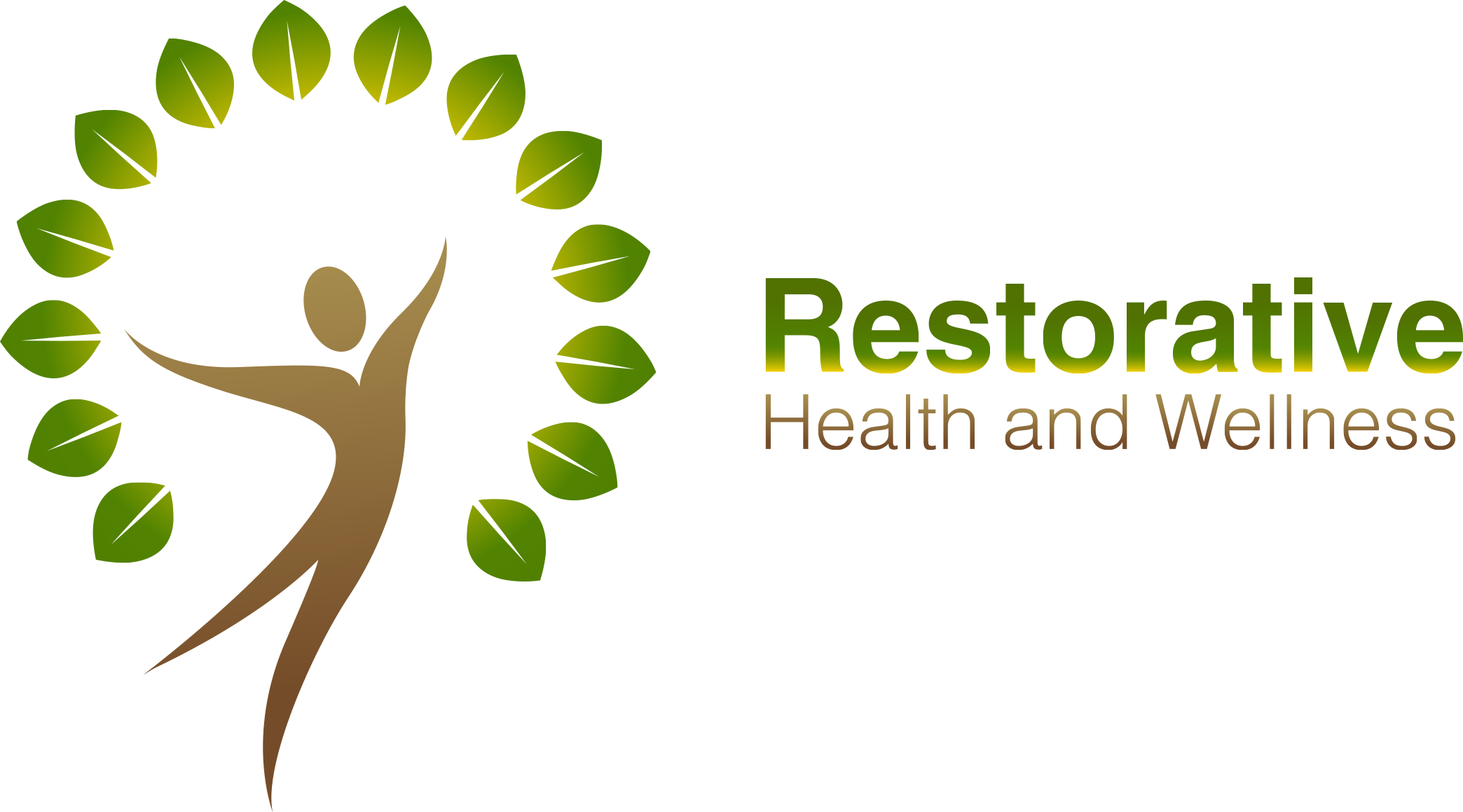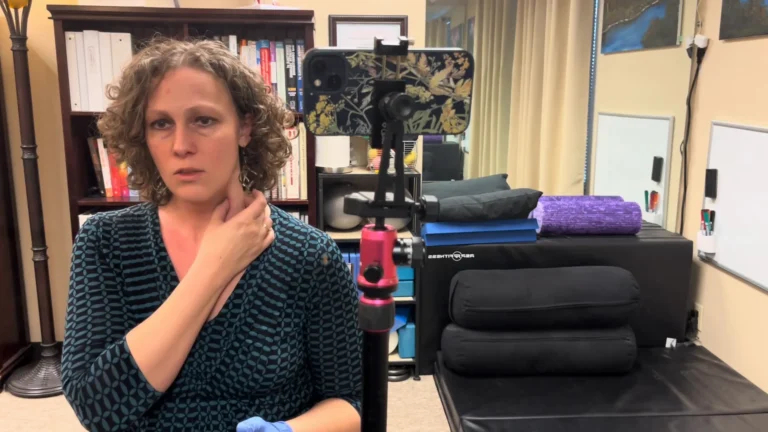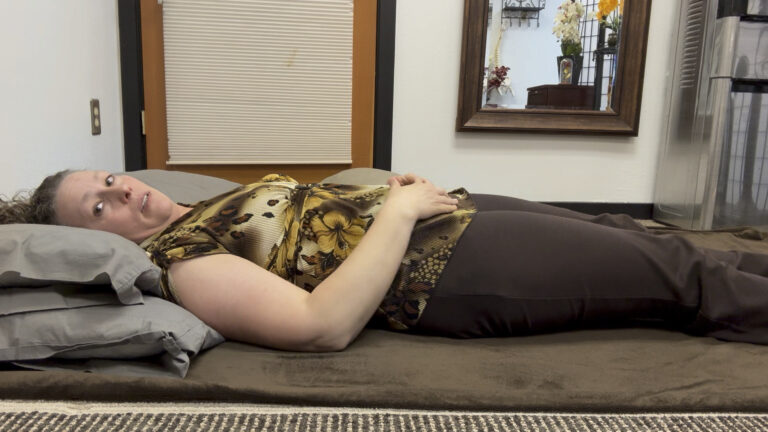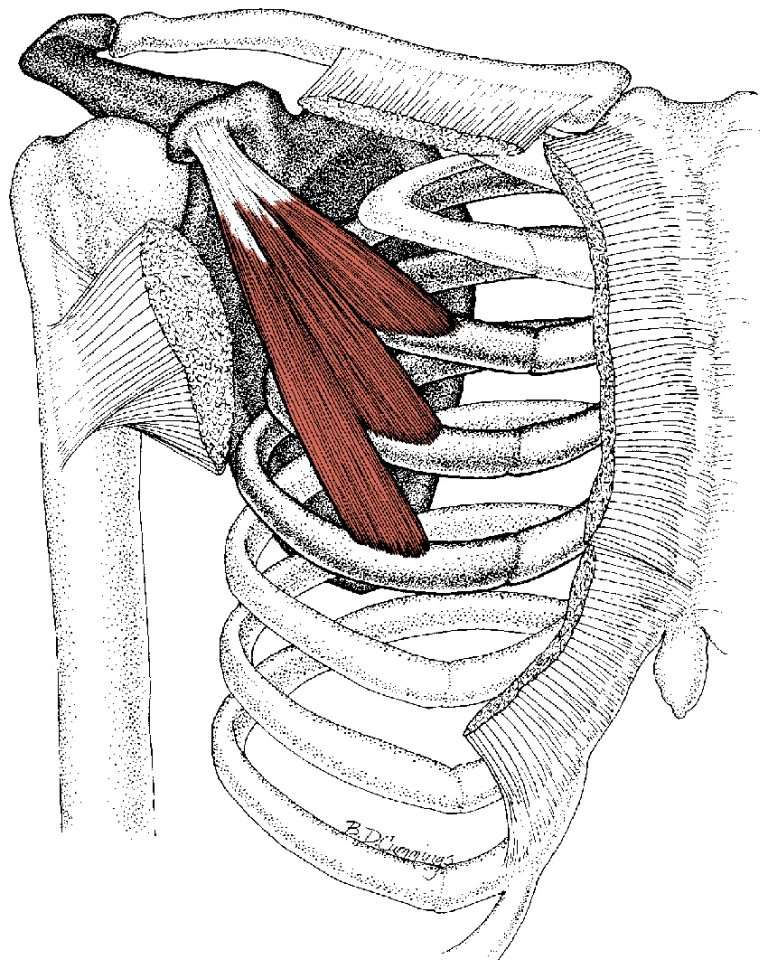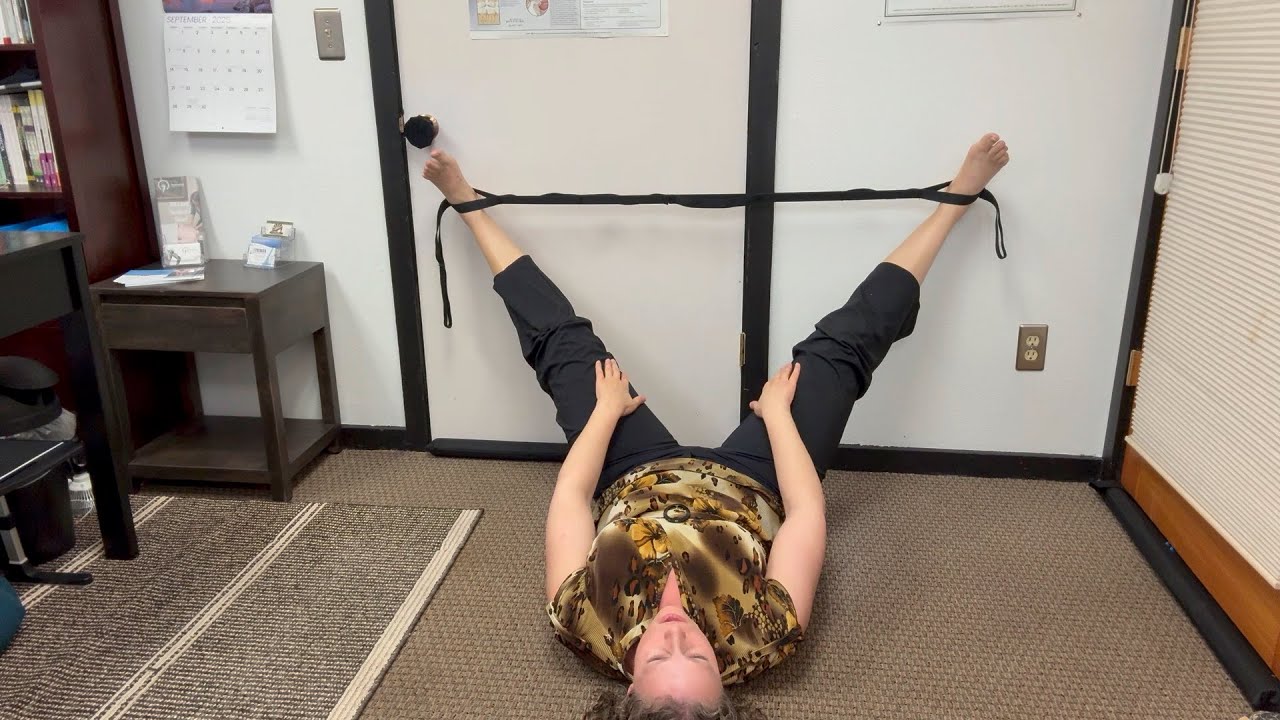
Hello — I’m Emily Boudwin, a neuromuscular massage therapist and restorative exercise specialist. In this post I’ll walk you through my favorite adductor strap stretch that uses the wall and the floor to safely open the inner thighs and ease tension around the pelvis and low back. If you like step-by-step tutorials you can follow along with the process I describe below. This adductor strap stretch is gentle, easy to set up at home, and great for anyone who sits a lot or feels tightness in their groin and inner thighs.

Why do an adductor strap stretch?
The adductor muscles — the tissues that run along the inside of your thigh — can shorten and feel tight from prolonged sitting, running, cycling, keeping your legs clamped together or simply poor posture. When the adductors are tight they pull on the pelvis and can influence your low back and hip mechanics. The adductor strap stretch helps lengthen those muscles in a supported way so your nervous system can relax and let the tissues elongate.
When I teach this stretch, I focus on support and relaxation rather than forcing range of motion. By using a strap with hand and foot holds and a small support under the low back (I often use a half dome), you can encourage a comfortable arch in the lumbar spine and allow the adductor muscles to release slowly. This approach is the heart of my adductor strap stretch routine.
What you’ll need
- A strap with segmented loops or foot/hand holds (yoga straps with stitched segments work well).
- A wall and a small clear area of floor about a foot away from the wall.
- A small half dome, towel roll, or lumbar support to maintain your natural low back curve if needed.
- Comfortable clothing and a timer.
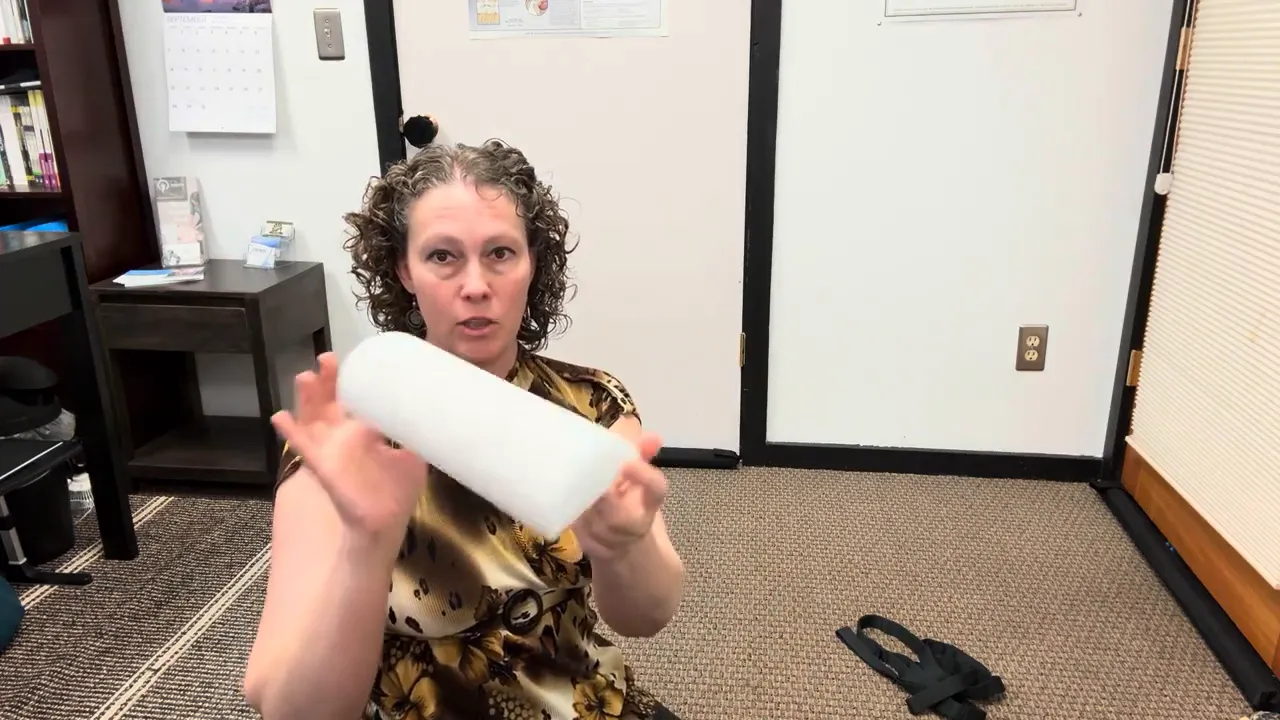
Step-by-step: How to do the adductor strap stretch
- Position yourself on the floor sitting about a foot away from a wall so your legs can slide up the wall. Place the half dome (or folded towel) under the low back to preserve the natural lumbar curve if you need extra support.
- Loop the strap around the middle of each foot.
- Slowly slide your legs up the wall so that the soles of your feet move into position. You can adjust how far apart your feet are along the strap to find the degree of opening that feels right. The strap’s loops let you relax your legs, which helps your nervous system calm down into the stretch.
- Once you are comfortable, focus on breathing. If you want a deeper inner thigh stretch, scoot a bit closer to the wall. If you begin to lose your low back curvature (your lumbar arch flattens), move a little away from the wall and add the half dome for support.
- Stay in the position for 30 seconds up to 5 minutes depending on your tolerance and goal. I typically encourage clients to hang out for 1–3 minutes on their first few tries so they can notice the gradual change instead of chasing a quick release.
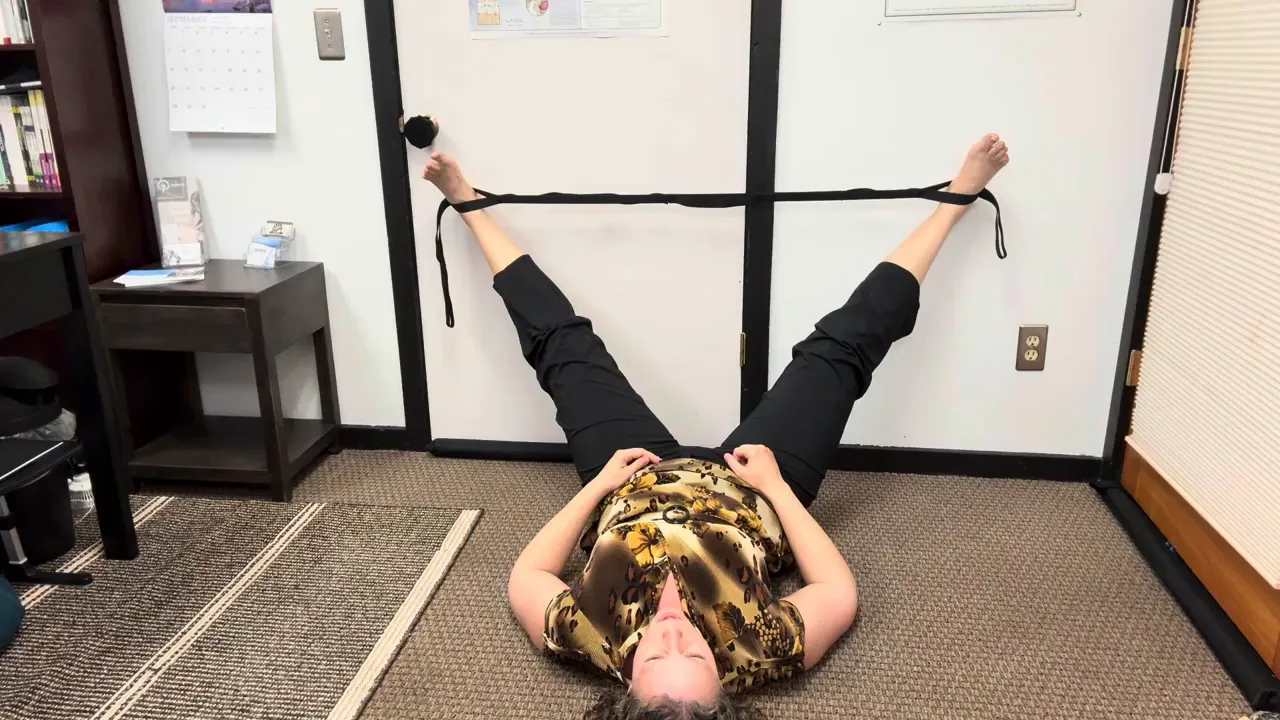
Key cues while you’re in the stretch
- Keep your breathing slow and even. Focus on letting the exhale soften the inner thigh and pelvis.
- Don’t hold tension in your legs. The strap should support the feet so your hips don’t need to “help” by lifting or bracing.
- Notice sensations: a gentle elongation or mild pulling is normal; sharp pain is not. Back off if you feel pins-and-needles, numbness, or sudden pain.
- Support your low back. If you lose your neutral curve when you move closer to the wall, scoot back until your natural arch returns or use the half dome for passive support.
Variations and troubleshooting
One of the things I love about this adductor strap stretch is how adaptable it is. Small adjustments create meaningful differences:
- If you feel the stretch more in the hamstrings than the adductors, move slightly further from the wall so the inner thigh is more targeted.
- For a deeper inner thigh opening, hold a longer duration (2–5 minutes) but stay within a comfortable intensity and keep the breath relaxed.
- Pregnant clients or those with hip replacements should consult their healthcare provider before doing wide leg stretches and may prefer a gentler seated version instead.

How long and how often?
Start with short sessions: 30–90 seconds is perfectly effective, especially if you’re new to stretching or working through sensitivity. As tissues relax and your nervous system becomes more comfortable, you can lengthen sessions to 2–5 minutes. I recommend practicing the adductor strap stretch 3–5 times per week if you have ongoing tightness, or incorporate it as part of a daily cool-down after workouts or long sitting periods.
Common mistakes and how to avoid them
- Forcing range of motion — Don’t push to a point of pain. You want a gentle elongation, not aggressive stretching.
- Holding breath — When people tense up, they hold their breath and tighten muscles. Breathe slowly and imagine each exhale softening the inner thighs a little more.
- Ignoring lumbar support — A flattened low back can change the stretch and create low back discomfort. Use a small support if needed to keep your neutral curve.
- Using a strap without loops — The little segments matter. Loops or stitched holds let you relax your legs; otherwise you end up gripping which increases muscle tension.
Who benefits from this stretch?
This adductor strap stretch is helpful for:
- People with tight inner thighs from sitting, cycling, or weight‑training.
- Anyone who experiences low back or pelvic tension related to restricted hip mobility.
- Athletes needing to improve lateral mobility or range of motion.
- Clients recovering from minor soft-tissue restrictions who need a supported, gentle approach.
Follow-up movements and complementary stretches
After the adductor strap stretch, you may want to follow with movements that reinforce hip stability and posterior chain length. Here are a few suggestions I often use with clients:
- Hamstring self‑massage or ball work — see my hamstring self‑massage tutorial at: https://restorativehealthandwellness.com/video-hamstring-self-massage/
- Periformis/glute releases and seated hip rotations — https://restorativehealthandwellness.com/video-periformis-self-massage-with-a-ball/ and https://restorativehealthandwellness.com/periformis-glute-deep-hip-rotators-4-stretch/
- Check your sitting mechanics and psoas awareness — tight psoas can influence low back tension: https://restorativehealthandwellness.com/does-your-low-back-hurt-the-psoas-muscle-could-be-the-culprit/
Precautions and when to seek professional help
If you have a history of hip labral tears, recent surgery, acute groin strains, or persistent sharp pain with movement, avoid unsupported wide-leg stretches and consult a clinician first. If stretching increases numbness, shooting pain, or instability in the joint, stop and contact a physical therapist or your doctor.
If you’re unsure how to adapt this adductor strap stretch for your specific issue, I offer personalized assessment and treatment — you can learn more about my practice and schedule a session here: https://restorativehealthandwellness.com/contact-us-and-schedule-your-massage/
My final tips for getting the most from the adductor strap stretch
- Be patient. Tissue change and nervous system calming take time.
- Choose support over force. A little lumbar support and strap loops make the stretch so much more effective.
- Include the stretch as part of a routine — consistency beats occasional intensity.
- Observe how your pelvis and low back respond and make small positional tweaks rather than large aggressive movements.
To learn more about related self‑care techniques, my other tutorials cover neck and headache relief, jaw self‑massage, and shoulder mobility. Here are a few resources you might find useful:
Headache and neck self‑care: https://restorativehealthandwellness.com/suboccipital_self_massage_guide/
Jaw and TMJ work: https://restorativehealthandwellness.com/tmj-self-massage-the-masseter/
General blog and resources: https://restorativehealthandwellness.com/blog/
Quick recap
The adductor strap stretch is a gentle, supported way to lengthen the inner thighs, reduce pelvic pull, and ease low back tension. Use a strap with loops and a small lumbar support, position yourself about a foot from the wall, and adjust distance until you feel a comfortable opening in the adductors. Breathe, relax, and let the tissue slowly lengthen over 30 seconds to several minutes. If you make small, consistent efforts you’ll notice meaningful improvements in comfort and mobility.
If you’d like one-on-one guidance or to explore how this stretch fits into a larger recovery or movement plan, visit my practice website and get in touch: https://restorativehealthandwellness.com
Thanks for reading — be gentle with yourself while you stretch, and enjoy the relief. — Emily Boudwin
Did this post help you! |
|
Then sign up for our FREE Email Newsletter! |
| Sign Me Up! |
